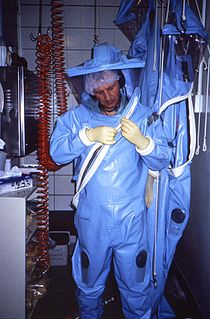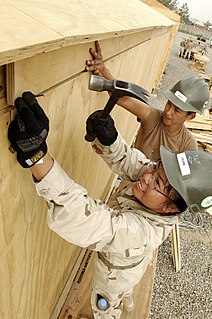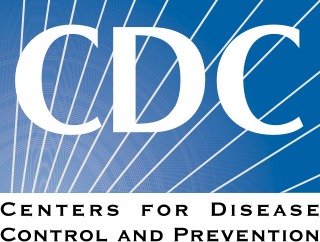
Biosafety is the prevention of large-scale loss of biological integrity, focusing both on ecology and human health. These prevention mechanisms include conduction of regular reviews of the biosafety in laboratory settings, as well as strict guidelines to follow. Biosafety is used to protect from harmful incidents. Many laboratories handling biohazards employ an ongoing risk management assessment and enforcement process for biosafety. Failures to follow such protocols can lead to increased risk of exposure to biohazards or pathogens. Human error and poor technique contribute to unnecessary exposure and compromise the best safeguards set into place for protection.
A bloodborne disease is a disease that can be spread through contamination by blood and other body fluids. Bloodborne pathogens are microorganisms such as viruses or bacteria. The most common examples are HIV, hepatitis B (HVB), hepatitis C (HVC) and viral hemorrhagic fevers.

The National Institute for Occupational Safety and Health is the United States federal agency responsible for conducting research and making recommendations for the prevention of work-related injury and illness. NIOSH is part of the Centers for Disease Control and Prevention (CDC) within the U.S. Department of Health and Human Services.

A biological agent—also called bio-agent, biological threat agent, biological warfare agent, biological weapon, or bioweapon—is a bacterium, virus, protozoan, parasite, or fungus that can be used purposefully as a weapon in bioterrorism or biological warfare (BW). In addition to these living and/or replicating pathogens, toxins and biotoxins are also included among the bio-agents. More than 1,200 different kinds of potentially weaponizable bio-agents have been described and studied to date.

Coccidioides immitis is a pathogenic fungus that resides in the soil in certain parts of the southwestern United States, northern Mexico, and a few other areas in the Western Hemisphere.
The National Center for Health Statistics (NCHS) is a principal agency of the U.S. Federal Statistical System which provides statistical information to guide actions and policies to improve the health of the American people.

Julie Louise Gerberding is an American infectious disease expert and the former director of the U.S. Centers for Disease Control and Prevention (CDC) and administrator of the Agency for Toxic Substances and Disease Registry (ATSDR).
Under United States law, "Biological Select Agents or Toxins" (BSATs) — or simply select agents for short — are bio-agents which since 1997 have been declared by the U.S. Department of Health and Human Services (HHS) or by the U.S. Department of Agriculture (USDA) to have the "potential to pose a severe threat to public health and safety". The agents are divided into (1) HHS select agents and toxins affecting humans; (2) USDA select agents and toxins affecting agriculture; and (3) overlap select agents and toxins affecting both.
The National Center for Immunization and Respiratory Diseases (NCIRD), formerly known as the National Immunization Program until April 2006, is charged with responsibility for the planning, coordination, and conduct of immunization activities in the United States. NCIRD is a part of the Centers for Disease Control and Prevention, located in Atlanta, Georgia, and housed in the CDC’s Coordinating Center for Infectious Diseases (CCID). The National Center for Immunization provides consultation, training, statistical, promotional, educational, epidemiological, and technical services to assist state and local health departments across the US in planning, developing, contracting and implementing immunization programs.

The concept of biocontainment is related to laboratory biosafety and pertains to microbiology laboratories in which the physical containment of pathogenic organisms or agents is required, usually by isolation in environmentally and biologically secure cabinets or rooms, to prevent accidental infection of workers or release into the surrounding community during scientific research. The term "biocontainment" was coined in 1985, but the concept stretches back at least to the 1940s.

An occupational hazard is a hazard experienced in the workplace. Occupational hazards can encompass many types of hazards, including chemical hazards, biological hazards (biohazards), psychosocial hazards, and physical hazards. In the United States, the National Institute for Occupational Safety and Health (NIOSH) conduct workplace investigations and research addressing workplace health and safety hazards resulting in guidelines. The Occupational Safety and Health Administration (OSHA) establishes enforceable standards to prevent workplace injuries and illnesses. In the EU a similar role is taken by EU-OSHA.

Signed into effect on 12 June 2002, the Public Health Security and Bioterrorism Preparedness and Response Act, (PHSBPRA) was signed by the President, the Department of Health and Human Services (DHHS) and the U.S. Department of Agriculture (USDA).
Workplace health surveillance or occupational health surveillance (U.S.) is the ongoing systematic collection, analysis, and dissemination of exposure and health data on groups of workers. The Joint ILO/WHO Committee on Occupational Health at its 12th Session in 1995 defined an occupational health surveillance system as “a system which includes a functional capacity for data collection, analysis and dissemination linked to occupational health programmes”.

John Howard is a physician, professor, and public health administrator. He served a 6-year term as the director of the National Institute for Occupational Safety and Health and was appointed to be a special coordinator to respond to the health effects of the September 11 attacks. In this role, Howard advocated for rescue workers, introducing a program to provide screening, medical exams, and treatment for them. In 2009, Howard was again appointed as director of NIOSH and as World Trade Center Programs coordinator for HHS. In 2011, Howard became the Administrator of the World Trade Center Health Program. In 2016, he became the first person to be appointed to a third 6-year term as NIOSH director.

A physical hazard is an agent, factor or circumstance that can cause harm with or without contact. They can be classified as type of occupational hazard or environmental hazard. Physical hazards include ergonomic hazards, radiation, heat and cold stress, vibration hazards, and noise hazards. Engineering controls are often used to mitigate physical hazards.

Radiation dose reconstruction refers to the process of estimating radiation doses that were received by individuals or populations in the past as a result of particular exposure situations of concern. The basic principle of radiation dose reconstruction is to characterize the radiation environment to which individuals have been exposed using available information. In cases where radiation exposures can not be fully characterized based on available data, default values based on reasonable scientific assumptions can be used as substitutes. The extent to which the default values are used depends on the purpose of the reconstruction(s) being undertaken.
Long Island Occupational and Environmental Health Center, is one of the NYS Department of Health (DOH) Occupational Health Clinics (OHC).

Occupational safety and health (OSH), also commonly referred to as occupational health and safety (OHS), occupational health, or workplace health and safety (WHS), is a multidisciplinary field concerned with the safety, health, and welfare of people at work. These terms also refer to the goals of this field, so their use in the sense of this article was originally an abbreviation of occupational safety and health program/department etc.
Many laboratories contain significant risks, and the prevention of laboratory accidents requires great care and constant vigilance. Examples of risk factors include high voltages, high and low pressures and temperatures, corrosive and toxic chemicals, and biohazards including infective organisms and their toxins.













